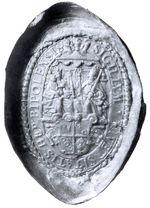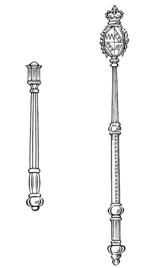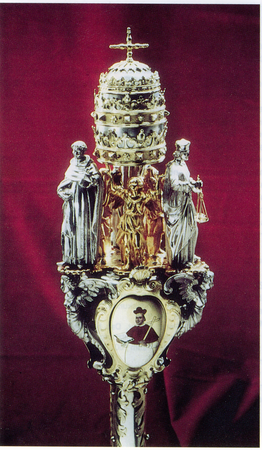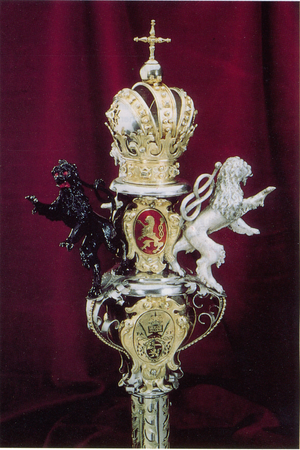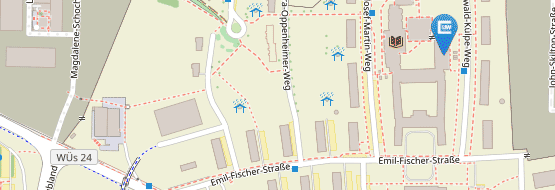Seal and scepter
The lost insignia of the University of Würzburg
During the opening ceremony of the reestablishment of the University of Würzburg on January 2, 1582, Prince-Bishop Julius Echter von Mespelbrunn presented the university with the matricula and the scepter as its insignia; the seal was obviously not yet ready and was added the following year. The academic insignia and signs of sovereignty of a university, which include, in addition to the much more recent chain of office of the rector, above all the university scepter and the university seal, were an expression of the university's own legal sphere as a corporate body as well as the judicial function of the rector. Since these insignia no longer exist at our university, they are in danger of being forgotten. To counteract this, their history is briefly recalled here.
The university seals
The great university seal was made of silver in 1583 and kept in the archives along with money, privileges and documents of the university. The image of the seal shows on one side a Mary with child as a sign of the patronage of Mary. On the opposite side there is probably not the founder of the university, Julius Echter, but Saint Kilian. The lower part is taken up by the sovereign family coat of arms with the Franconian rake, the storm flag of the High Diocese of Würzburg and the family coat of arms of the founder Julius Echter. The year given, however, refers to the production of the seal and not to the founding of the university. Until the 20th century, the seal was used on special occasions concerning the university as a whole, such as the issuing of privileges and solemn contracts. Even today it is often used as part of the letterhead.
In the 18th century, the rectorate seal was added, which shows only the founder's coat of arms as an image. With the incorporation of Würzburg into the Bavarian state, the university became one of the three state universities and lost its corporate independence. Its organization was completely reorganized in 1803/04. However, the old seals were allowed to remain in use. It was then the Prorector himself who requested a new seal with the Bavarian coat of arms in 1804. This was used until 1808, despite the beginning of the Tuscan rule in 1805. After that, the old seals from the time before the secularization came back into use. Even later, seals with the royal Bavarian coat of arms were not used. The use of the old endowment seals was expressly approved by the Ministry of the Interior for all universities in 1830.
Until the 1930s, the older university seals were kept in the Martin-von-Wagner Museum. There they were destroyed during the bombing of Würzburg on March 16, 1945, together with the coin cabinet and parts of the museum's collection.
The university scepters
There is no precise information about the first scepter of the university, which was awarded by Julius Echter. As a source, we have to resort to illustrations in the university's registers. The older scepter was a finely canelized staff with a flask-shaped structure. From later descriptions of the scepters, it can be assumed that this was the silver-plated wooden staff mentioned there. In 1723, a more elaborate silver-plated scepter with a prince's hat and Echter coat of arms was made under Prince-Bishop Johann Philipp Franz von Schönborn.
This older scepter from 1723 was kept near the antechamber in a cabinet, hidden behind the gowns. In August 1788 it mysteriously disappeared. Since the door had not been broken open, suspicions arose that a member of the university provided with a master key might have committed the theft. Extensive investigations were initially inconclusive. However, the scepter seems to have reappeared at an unknown time, because in a report to the Ministry of the Interior in Munich in 1846, the two scepters are described, albeit in poor condition.
Because of this desolate condition, the university was assigned the two scepters of the Salzburg University, which had fallen to Bavaria and been secularized in 1810 in the course of the Napoleonic transformation of Europe, for its use by royal resolution in the same year.
(Kopie 1)
Author: Marcus Holtz






